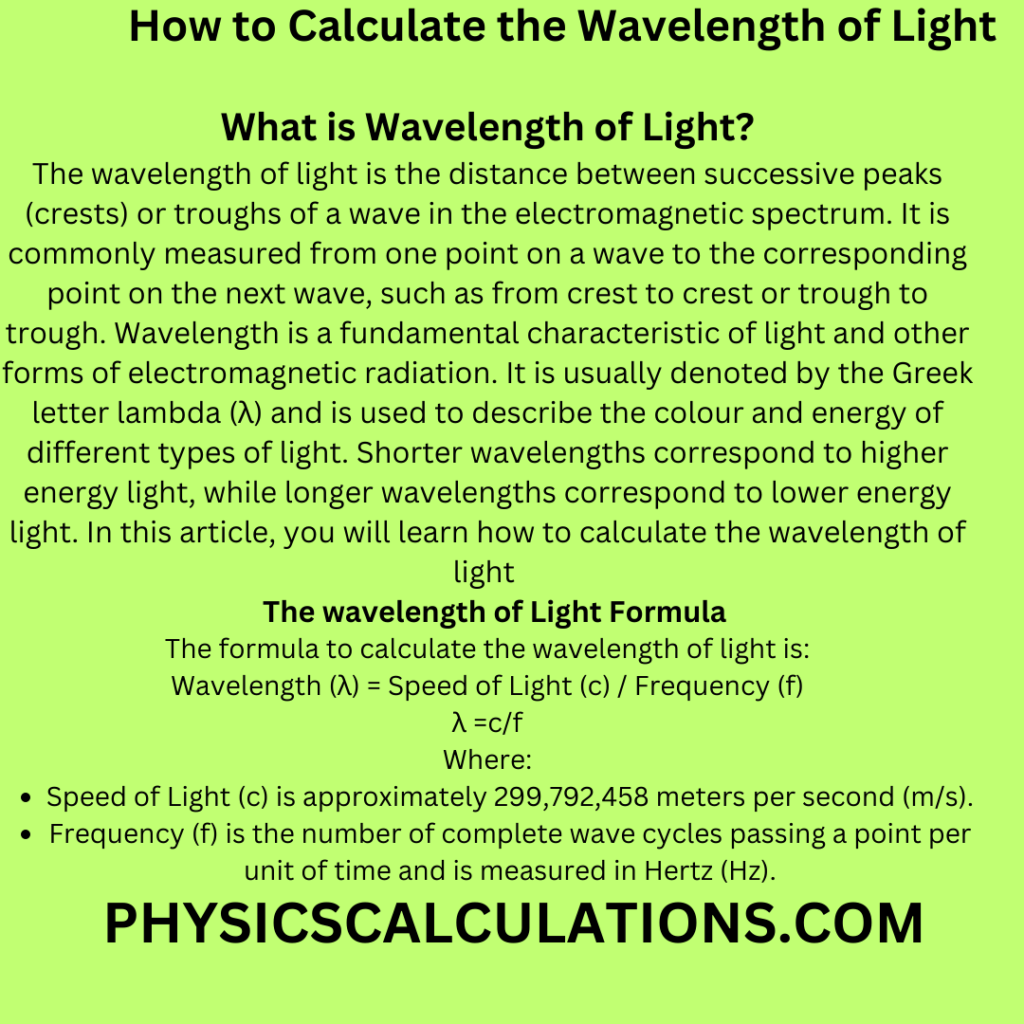What is Wavelength of Light?
The wavelength of light is the distance between successive peaks (crests) or troughs of a wave in the electromagnetic spectrum. It is commonly measured from one point on a wave to the corresponding point on the next wave, such as from crest to crest or trough to trough. Wavelength is a fundamental characteristic of light and other forms of electromagnetic radiation. It is usually denoted by the Greek letter lambda (λ) and is used to describe the colour and energy of different types of light. Shorter wavelengths correspond to higher energy light, while longer wavelengths correspond to lower energy light. In this article, you will learn how to calculate the wavelength of light

Wavelength of Light Formula
The formula to calculate the wavelength of light is:
Wavelength (λ) = Speed of Light (c) / Frequency (f)
The second wavelength of light formula we can use is: λ = hc/(En – E0)
Where:
- Speed of Light (c) is approximately 299,792,458 meters per second (m/s).
- Frequency (f) is the number of complete wave cycles passing a point per unit of time and is measured in Hertz (Hz).
- E = Energy level,
- En = Excitation energy of nth level
- E0 = Ground state energy level
- h = Planck’s constant, and
- f = frequency
Additionally, the wavelength of light is inversely proportional to its frequency. As the frequency of light increases, its wavelength decreases, and vice versa.
How to Derive the Formula for Calculating Wavelength of Radiation
Since E = hf
Where
E = Energy level, h = Planck’s constant, and f = frequency
If ΔE = En – E0
Where En = Excitation energy of nth level
E0 = Ground state energy level
We can now say that
En – E0 = hf
and if f = c/λ
where c = speed of light = constant = 3 x 108m/s, and λ = wavelength of the radiation
By λ subject of the formula from f = c/λ. We will have
λ = c/f
Now we put the equation (f = c/λ) into En – E0 = hf to substitute f. This expression will now become
En – E0 = h x c/λ
The above expression becomes
En – E0 = hc/λ
Now we have
λ = hc/(En – E0)
Therefore, the formula for calculating the wavelength of radiation is λ = hc/(En – E0)
Solved Problems: How to Calculate the Wavelength of Light
Here are solved problems on how to calculate the wavelength of light
Problem 1
The ground state of hydrogen may be represented by the energy – 13.6eV, and the first excited state by – 3.4eV. The scale in which an electron is completely free of the atom is zero energy. Calculate the wavelength of the radiation.[ Take Plank’s constant = 6.6 x 10-34 Js, eV = 1.6 x 10-19J ]
Solution
Data:
electron volt, eV = 1.6 x 10-19J
The first excited state of the Hydrogen atom, En = E1 = -3.4eV = -3.4 x 1.6 x 10-19 = -54.4 x 10-20J
Ground state, E0 = -13.6eV = -13.6 x x 1.6 x 10-19 = -217.6 x 10-20J
planks constant, h = 6.6 x 10-34 Js
speed of light, c = 3 x 108m/s
λ = ?
Now we apply the formula for calculating the wavelength of radiation is λ = hc/(En – E0)
by substituting our data into the above equation, we now have
λ = (6.6 x 10-34 x 3 x 108) / (-3.4 -[13.6])eV
The above expression will now become
λ = (1980 x 10-28) / (10.2eV)
which is also equal to
λ = (1980 x 10-28) / (10.2 x 1.6 x 10-19)
Therefore, λ is equal to
λ = (1980 x 10-28) / (163.2 x 10-20)
Thus,
λ = 12.132 x 10-8m
Therefore, the wavelength λ, of the radiation is 12.132 x 10-8 meters
Problem 2
An electron jumps from one energy level to another in an atom radiating 4.5 x 10-19 joules of energy. If Planck’s constant is 6.6 x 10-34 Js. What is the wavelength of the radiation? [Take c = 3 x 108 m/s]
Solution:
Data
Energy excitation, E = 4.5 x 10-19 J
Speed of light, c = 3 x 108 m/s
Planck’s constant, h = 6.6 x 10-34 Js
The wavelength of the radiation, λ =?
and λ = hc/E = (6.6 x 10-34 x 3 x 108)/(4.5 x 10-19) = (1980 x 10-28) / (4.5 x 10-19) = 4.4 x 10-7m
Therefore, the wavelength of the radiation λ is 4.4 x 10-7 meters
Problem 3
The work function of a metal is 8.6 x 10-19J. Calculate the wavelength of its threshold frequency. [speed of light in vacuum = 3 x 108 m/s and Planck’s constant = 6.6 x 10-34 Js]
Solution
Data
We apply the formula f = hc/W
The work function of a metal, W = 8.6 x 10-19J
Threshold frequency, f =?
Planck’s constant, h = 6.6 x 10-34 Js
Speed of light, c = 3 x 108 m/s
Thus,
f = hc/W = (6.6 x 10-34 x 3 x 108) / 8.6 x 10-19 = 2.3 x 10-7
You may also like to read:
How to Calculate Power in a Circuit
How to Find Displacement in Physics
Reference